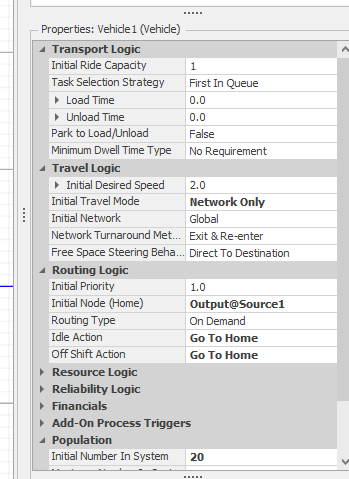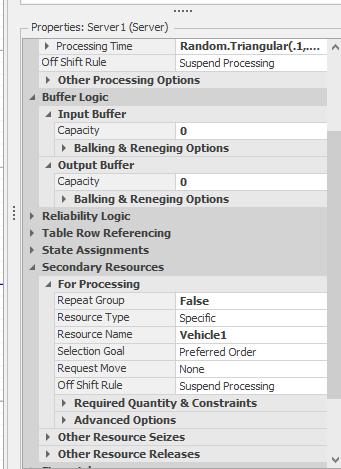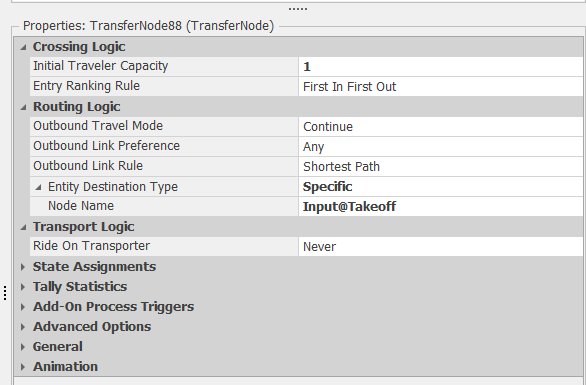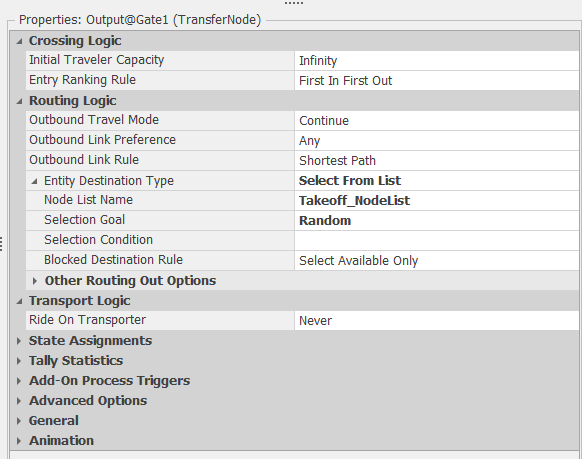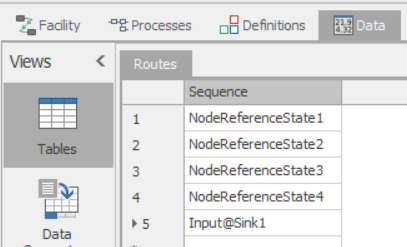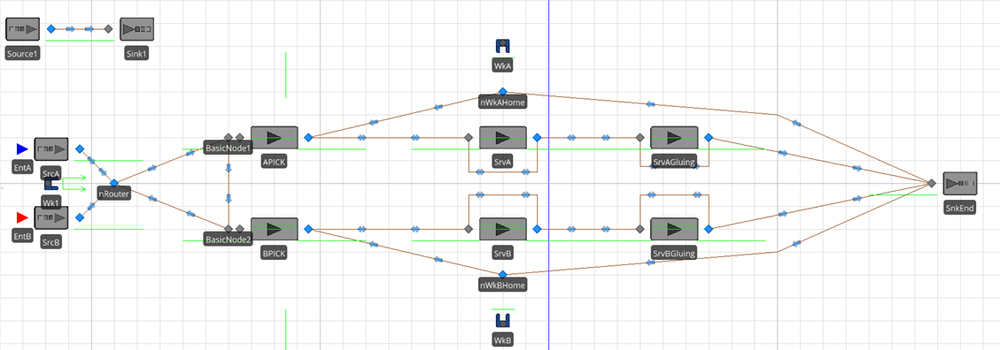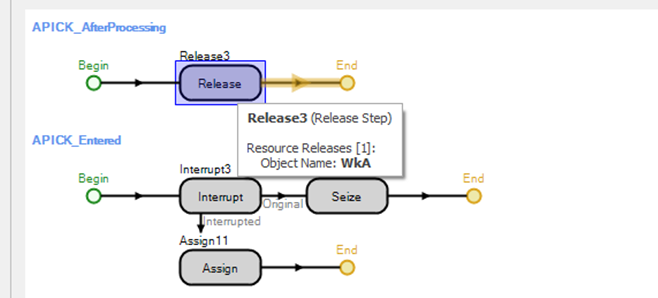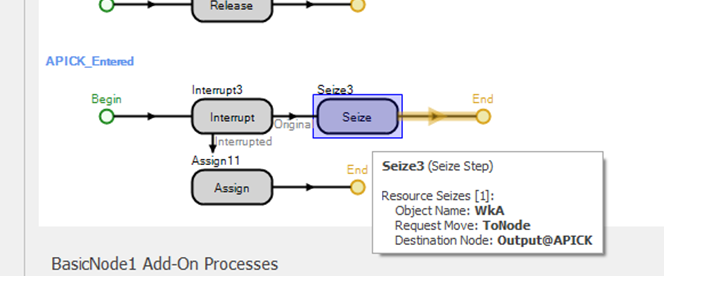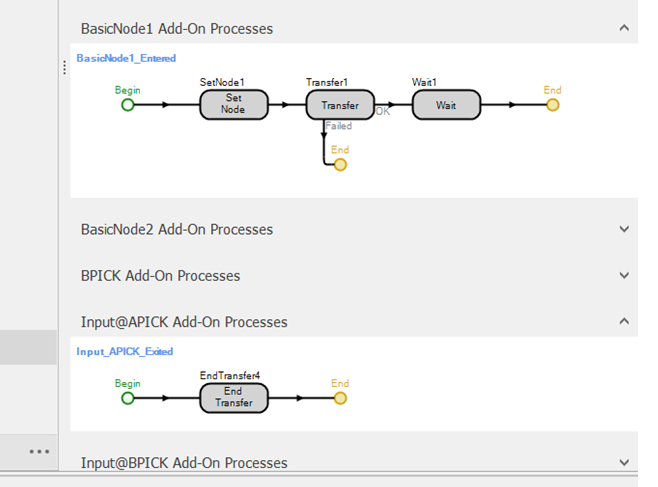Search the Community
Showing results for 'sink percentage of entities'.
-
Hello all I am relatively new to Simio and DES. I am trying to model a pallet conveyor. It is a closed loop conveyor. I use the "vehicle" as the pallet that loops around the conveyor. At the source the part (default entity) is loaded on the pallet. At the sink the part is unloaded. The problem that I am encountering is that the vehicles from time to time pile up at the sink, then after a certain amount of time they continue back to the starting point "Source1". This happens more the more I increas the "initialnumber in system" of vehicles The transfer-in Time for the sink is set at 0. At the model trace I read this for the "Input@Sink1" : "the in Token waiting at VisitNode step for '1' other processes to complete." I would apreciate any advice. Many thanks! Vehicle_stuck_at_sink.spfx
-
Thank you for the quick and detailed response! I see the error I was making with work schedule and have tested it on one server, it seems to work as intended. Since each of my servers have a different capacity, would I need to create a unique work week and unique day type for them all? Or is there a quicker work around? The manual inputs for the date time are a great work around, I'm only modeling for a few years so I don't mind inputting a few dates. What I mean by there being no buffers is that no server can have a queue. I used a list for selecting the destination on the output node of each source (total of 8 ) where it's a hierarchy. It can go to a select number of servers and if all of them are full it goes to a dummy server of infinite capacity that exits the items to an overflow sink.
- 2 replies
-
- server
- work schedules
-
(and 2 more)
Tagged with:
-
Ok, I think that I sort it out. I am not very confident of what I do but I think that it works now: I changed the Vehivle "Routing Logic". Idle action: Go to home AND I changed for every server, secondary resources: Earlier it did not work because the vehicle was stuck at the sink waiting for an entity to be available at the source. The idle action for the vehicle was to "Park at home"..
-
Hello River, I downloaded your files. The Gate512 was missing. I removed the information in the "30 Departure.xlxs" file that I can run the model ;-). Generally I understood how it works. Answer to your first question: I think you mean these two ways, right? From the left and from the right. In this case I saw that you used the "Routing Logic" in like all Transfernodes. The Outbound Link Rule is "Shortest Path" and you set the "Node Name" to "Input@Takeoff" Simio is using everytime the shortest link path now. Like in the screenshot below: In my opinion it would be better to set the destination once after the Entity got created in the Source for example :-). There are different ways to do that. In your model I removed all Routing Logic in the Transfernodes and used the Routing Logic only in the Output-TransferNodes of the Sources. In Simio you need only to use one time a SetNode-Step or a Routing-Logic to set the destination of an Entitiy and Simio will follow the paths or travel in the FreeSpace. You can use for example a NodeList with 2 different destinations and this Routing-Logic: With the "Selection Goal" Random Simio will randomly choose the destination from the NodeList. I uploaded you your model with the changes as an example: Problem on the taxiway version 17A.zip What did I changed? 1) I removed the Routing Logic in all TransferNodes. 2) I added new Routing Logic to the TransferNodes of the Output-Node of the Sources. 3) I added a NodeList with 2 new Nodes. 4) In the two new Nodes I used a Nodes-Entered-Process and a Transfer-Step to transfer the Entity to the Input of the Sink. Answer to your second question: You can change the destination of an Entity any time. In the Path (Link) you have a function called "NumberTravelors" for example to get the number of travelors currently on this path. So you can use a Expression like "Path123.NumberTravelors < 2". This can be used to decide if a way is full allready that the other way get selected. Or you can use a Integer-State and count up and down. I would use a Node-Entered-Process in the last possible node with a Decide-Step and two SetNode-Step in this case :-). I hope my answer will help you. When you have any other question, you are welcome! Best regards Pascal
-

Changing Sequence table over time
dsturrock replied to antonio6vieira's topic in SI General Discussions
I have attached a simple model using model states to illustrate. I think it should work in a similar fashion using entity states. First, I define the states: Then use those states as Sequence destinations: Until you provide each of those states a value, the Sequence will make no sense and the entity won't know where to go. So on the Source I use an Assign to initialize all the values. This will direct the entity sequentially through Servers 1-4, and then to the Sink: Finally, just to illustrate the technique, on the output node of Server3, I interrupt the normal sequence by Assigning it to instead go to Server5 as its 4th step: If you convert these states to Entity states instead (I was just lazy), I think it should work the same but allow you to selectively override any Sequence Step at any time. UsingStatesInSequences.spfx -
Hi everyone, I am trying to model entities moving from 10 origins (sources) to 10 destinations (sinks). The entities are simultaneously created according to a certain mix (Entity1 (85%), Entity2 (10%), and Entity3 (5%). However, the number of entities created per event is according to a certain distribution. There is an OD-matrix that captures the number of entities moving from origin to a specific destination. Let's say there are 10 destinations, than the destinations of the Entities are determined according to the OD-matrix: Entity1 and Entity2 can move to any of of the sinks. Entity3 can only move to one specific sink. One solution I came up with was to add weights to Connectors and assign destinations using TransferNodes, but I think that this is very inefficient. I then started to work with DataTables, but I cannot figure out how to probabilistically assign the destinations of the entities. My question is: how to model the probabilistic destination assignment of Entities using DataTables in such a way that it is relatively easy and flexible to add or remove Sources/Sinks? I have added the model for you to see, I hope that you can help me! Many thanks in advance Simple_OD_creation.spfx
-
I am very new to simio and need to create a model for a class. My problem statement is based on services provided by a cafetería. I have 3 types of clients, with their respective proportions. Additionally, each client has their own sequence. I have already made a data table with the proportions and a sequence table for each client. After the clients finish their sequence, every client goes to the same sink (which represents the cashier). What I don't know how to do is show how that sink can provide two types of services: credit cards and cash. On top of that, the credit card service must be 63% of the total entities that go into the system. I will really appreciate any help you can give me!
-
Hi all, I am working on a building evacuation project through Simio. I want to know how can I block a sink object, so entities can not exit through that sink. I also need to know if I can somehow define this situation in referenced property under Experiment and try different scenarios. For example in each scenario I block one of the exits and monitor the number exited (survivors) or evacuation time. My other problem is simulating fire with different rates and interaction of it with the entities, as when they see fire they avoid running toward that direction and change the route. Thank you for your help,
-
Hi All, I want to do some calculations just before the simulation ends. I did it previous versions without problem but now on version 15.247, "on run ending" add-on process is not being executed.I tested it even on a new simple model file with source server sink. There is just two assign steps with breakpoints on the add-on process. But in model trace it doesnt show the add-process name, the state variable value is not assigned, and breakpoint is not reached. Anyone experiencing the same problem in this version? Is there a quick solution to this? Or do I have to install older version? Kind regards, Tolgahan
-
Hi There, I have lots of experience in simulation but I'm new to Simio - my apologies if my Simio vocabulary/conceptualization is off or if this question has been asked already. I'm working to build a queue model simulation with a network of services and multiple staff types. In my mind, it makes the best sense to do this using the standard library of servers and resource pools (to visualize the network for stakeholders and be able to model multiple staff with different schedules that can each respond to multiple services). Right now, I am starting with a single stage M/M/c type queue to make sure that my implementation is correct before scaling this upwards. I checked out the SimBit titled 'Source – Server – Sink' that has three different M/M/c implementations; however, none of them use Resource Pool objects or combine process triggers with the standard library. I was able to implement a basic model that tries to combine a resource pool with a server by triggering separate Seize and Release process triggers on entry to the server object and after the processing time is completed, respectively. It runs without error; however, the results for average time in system (calculated by an average of a tally statistic that is only recorded for every 500th customer/entity), the results are one third less than in a scenario where I don't use a resource pool and set the capacity of the server explicitly, (which I validated against M/M/c formulae results). Does anyone have tips for how to link servers and resource pools and troubleshoot this scenario? Is there a SimBit or other example out there that is relevant? Am I triggering the seize/resource processes at the wrong points in time? Or is my framework for how to conceptualize this in the Simio environment missing a key concept? Thanks!!
-
Hello all and thanks for letting me be a part of Simio Insiders I am closing in on having done my first source, server, sink simulation. It is done as a part of a University study and is due next week. Feel free to download my attempt and have a look at it. The process I want to simulate is as follows: 1. Chef recieves an order of 1-6 beef patties 2. The chef puts the patties in a grill, that has capacity of 12 patties, and a base cooking time/process time of 1 minute total (that increases with order size) 2a. If more orders come in, while the grill is preparing an existing order, they have to be put in queue, as the grill should not be interrupted. When the grill/server is free again, it will take all - or up to 12 - from the queue, depending on how many orders are in queue 3. The patties go to the sink I am using a Time Varying Arrival Rate table from real life data, on the course of 2.5 hours. The trouble I am having is as follows, and please, feel free to only answer some of them, if you don't have answers for all: _____________________________ a) Order size We want to have orders vary from 1 to 6 patties, per order, in a way that resembles this distribution: 1 (min order size) patty ; was ordered 2 times 2 patties ; was ordered 18 times 3 patties ; 9 ... 4 ; 7 5 ; 3 6 (max order size) ; 1 I have not been able to imitate this behavior. Right now, I use Entities per Arrival to be Random.Possion(2), as this looks a bit like this distribution above, but the flaw with Poisson is (I believe), is that an order-size of 0 patties is a possibility, which doesn't make sense. I have also been playing around with a lookup table, without a real clue on if that's the right thing to do. What should I do to resemble this? _____________________________ b) Server (grill) behavior The problem right now is, that the grill (server) can keep taking in patties, even if it's already processing. That doesn't make sense, if you think about it, since you can't put patties into a closed grill. I want it to start preparing an order, as soon as it gets it, and just let the queue of patties build up until the grill is free again. Then, take up to 12 patties into the grill. _____________________________ c) Process times For the grill, I want the process times to follow the amount of patties in the grill. The grill takes 60 seconds to prepare a patty, and we assume each patty takes 2 seconds to load. Therefore, we choose to simplify that: 1 patty takes 62 seconds to make 2 patties take 64 seconds 3 ; 66 sec 4 ; 68 sec 5 ; 70 sec 6 ; 72 sec 7 ; 74 sec 8 ; 76 sec 9 ; 78 sec 10 ; 80 sec 11 ; 82 sec 12 (max grill capacity) patties ; 84 sec Which is basically y = 2x + 60 In the simulation I uploaded, each patty, no matter the order size, just takes 60 seconds, which is incorrect. How do I get the grill to behave like this? _____________________________ d) Batching After getting the server behavior to work, I want to work with the utilization of the grill. My idea is, that if the server (grill) is told NOT to start preparing patties right at the moment, it receives the order, e.g. if the quantity is small, but instead waits a certain amount of seconds, to see if more orders should come in, maybe the total wait can become less. There shouldn't grow any large queues with the current arrival rates, but if we double it, it might become relevant, so customers shouldn't wait for too long. Another option would be, that it waits till a certain amount of patties are in queue, such as a minimum of 6. _____________________________ Thanks again, and I sure hope you will take a look at this! You are more than welcome to edit the file, but it is also fine, if you just type in here. Best regards, Johan Grill.spfx
-
Hi all, I'm trying to do an information network model, and I need to have hundreds of thousands of "nodes" in this model, each node would need a source, server, and maybe a sink. And the "nodes" need to be connected to each other as well. Is it possible do create such "node" automatically instead of manually creating them? And would the runtime efficiency be okay? or should I switch to other simulation software/language? Any suggestions would be appreciated. Thanks!
-
I'm interested in calculating a yearly production rate. Essentially I could do this if I ran my simulation for 1 year and looked at the output. The number of entities destroyed by my "completed" sink will be what I'm looking for. How do I determine this value if I'm running for longer than 1 year? For example; If I run for 5 years, and I'm watching my model run, at week 186 I'd like to know how many entities had been destroyed by my "completed" sink between weeks 134 and 186 to determine my yearly production rate.
-
Hello All, I'm trying to create a model that will keep track of processing time for each transaction processed and reroute transactions that exceed a processing time threshold to an alternate sink. Initially, I attempted to rework the "Remove from Allocation Queue" Simbit, but the "Remove" process only seems to work with queues. The model itself is very simple. Single source with a random exponential inter-arrival time, single processor with capacity of 50 and 2 sinks; one for completed transactions and one for long running transactions which are manually routed. Any guidance you can provide would be greatly appreciated. Thank you, Ryan
-
Entity Distance travelled on Transporter
Liz Millar replied to ttarkan's topic in SI General Discussions
Hello! With your current approach, you need a way to aggregate the distance traveled per each entity. Each entity in the population is collecting their own distance traveled, but on the Output Statistic, you are looking at just the Instance, ProductA. The Instance will not automatically aggregate the population's values. If you were to specify a specific population index, for example ProductA[5].DistanceFunction, the Output Statistic would return the 5th entity in the population's distance function and you should see a value. However, making an Output Statistic for each population index would be inefficient and tedious to collect. I recommend using a global/model level State Variable. This State Variable could be summed as a ProductA entities leave the system. So the Product A entities will continue to collect their individual distance traveled as you have set it up, but then prior to exiting through the Sink, add their distance traveled to a running total State Variable. That total could then be divided by the number of entities destroyed giving you an average distance traveled. -
Hello, I have the following situation, I have a source followed by 3 servers in parallel. These servers are then connected to a fourth server, which finally leads to the sink. The thing is I need that the 3 first servers must hold the entity (stay blocked) until the fourth server is free. Additionally, if one of the 3 servers in parallel has capacity available, this one must stay blocked until de fourth server finishes its process. I attached the model I made, and the main problem are the three servers in parallel which are staying blocked after the first entity pass through. Thanks in advance block.spfx
- 2 replies
-
- blocked server
- queueing
-
(and 1 more)
Tagged with:
-
I have a model where I have 7(seven) entities and for each entity there are many possibilities paths. Is possible an entity be programmed with multiple sequences tables? For example, the entity can go to source -> server1 -> sink, and also randomly it can go to source -> server2-> sink, something like that.
-
I'm having trouble at the interruption step. Yes, I have looked at InterruptibleOperator, InterruptingServerWithMultipleCapacity, InterruptingAcrossMultipleServers. Despite all of that, I still cant figure it out. What I want to happen: Worker1 carries both entites and drops at respective servers (A/B PICK) and doesn't leave until processed. WorkerA/B stops whatever its doing (though it does not stop if transporting) and is siezed when Worker1 brings the entity to A/B PICK. Worker1 moves on and WorkerA/B does what it needs to. Here's the deal in WorkerA/B areas: The worker stays with an entity at serverA/B. Th worker can be interrupted at that process and go to A/BPICK to process the newer entity. The worker can't work on that newer entity right now because there is already an entity in serverA/B. So the newer entity waits at A/BPICK. At the gluing servers, the workers only have to get the entity into the processing state, but after that can go grab an entity waiting at A/BPICK and start it at serverA/B. Once the gluing process is done, it should be a priority to stop working at serverA/B and go take the entity at end of the gluing server to the sink. Then goes back to working at serverA/B. And the cycle continues. Here's a youtube video of what happens: Here's my add-on processes. I'm only concerned with A path because I can figure out B from A. ^ The idea was to turn the EntA at one of processes that are interrupted to yellow to symbolize the interruption of that entity^ ModelForQuestionCOPY4FORUM.spfx
-
Hi - 2 questions: 1. My model has people coming on shift, being transported to various locations, and then ending their shift at the sink near the source. However, I need them to get picked up and have ALL cycled through the lunch break server. Right now, out of the 35 people on shift, only 1 person got lunch, and only 6 people had their end of shift. How do I constrain the server to ensure the vehicle drops everyone at the lunch server and then the EndOfShift? 2. I would like to model 2, 12-hour shifts (each with the 35 people). I need all 35 to show up at the same time. This is my source Entity Arrival Logic. How do I change it to have two sets of 35 show 12 hours apart?
-
12-hour Shifts with Lunch Breaks and Vehicle Transport
Ryan Welch Lutttrell replied to M_A's topic in SI General Discussions
Hi M_A, 1. This is one is a bit difficult to provide direction on without seeing how the rest of the model is structured. If all your processing times are deterministic and you are using a sequence table to route your entities, then you should be able to add the lunch break into the sequence. Similarly, make sure the sink is included at the end of all your entity sequences. Also, make sure the model run time is long enough to process all employees. That may be why they aren't showing up at the sink. 2. Change your interarrival time to 12 hours, and set your Maximum arrivals to 2. Thanks, Ryan -
Sorry Cam.Laboy, I missed this part of your message. Of course you had better to define servers instead of sinks. This time you should use Input@Server instead of Input@Sink in the sequences table. By this way, you can collect some other useful statistics, i.e., payment time, payment queue length etc., as well.
-
Hi Cam.laboy, I mean you have to define new customer types and include sink objects into their sequences. I attach a picture of how to revise probabilities of these new customers. Hope it helps.
-
yes, it works if the sink objects are in the course of these customer entities.
-
To keep things simple, let's just say I have two servers. At these two servers are 3 resources each: Server A has Resource 1, 2, and 3, and Server B has Resource 4, 5, and 6. I have a pre-determined list of Resources that needs to be selected. For example, the Entity would need to go to Server A to select Resource 2 and then Server B to select Resource 4 and then exit. I need help with the logic to help make this work. But then, once the order is finished, the resources to capture changes so the entity might have to go to Server B to get Resource 6 and then Server A to get Resource 1, then to the sink. In the big scheme of things, I'm going to have many Servers and each Server is going to have at least 4 Resources. I'm trying to figure out how to do this in the most efficient way whether it be through lists or built in properties. Thanks in advance!
-
Visualize Utilization in Facility Window or Dashboard Reports I have a source – several servers – sink model. It’s a model of an assembly line production meaning that the entity cannot continue to Server 2 if Server 2 is occupied. The servers have different production times and I want to compare the different utilizations of the servers. I did this over the experiment window and the expression Server1.ResourceState.PercentTime(1) . In a next step I want to visualize these utilizations next each other with something like a bar chart. I came up with two possible ways of doing so but both didn’t work. In the facility window with the animation tools like the linear gauge. The problem here is probably that the expression “PercentTime” has no reference to what the overall time is, while the model is running, and therefore the gauge shows constant 100% the whole time. Or in the experiment window in the dashboard reports which doesn’t have percent time as a response. Is there any other way of visualizing the utilization?


